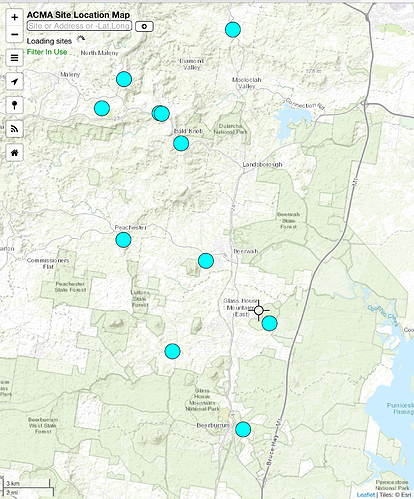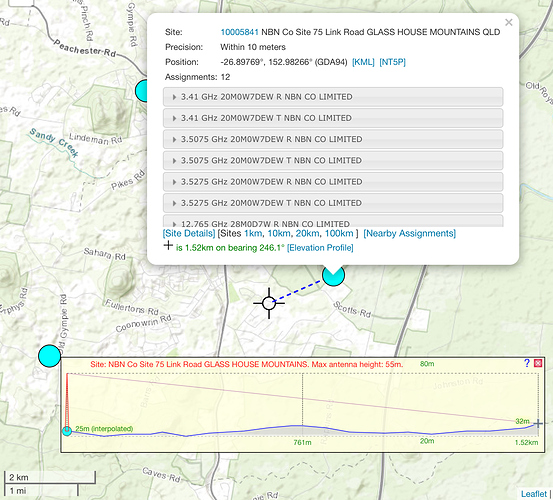Every time I see this topic title I marvel at the word ‘fixed’. Yes, I know, but.
For anyone still wondering about the NBN Fixed Wireless service. A handy tool to find your local NBN Fixed Wireless towers. It can be a little slow to load data, or that may just be my internet connection.
https://web.acma.gov.au/rrl/site_proximity.main_page
You may put in your street address or something close. There is also the option to zoom on a map and drop a pin by selecting the pin button top left of the map.
Here is an example for my region. In the menu to the Top Left,
To limit the data set to the NBN system. In the text menu drop down select Filter Sites by Assignments/Licenses, and enter NBN into the Clients-Any Details-Matches search text box.
A handy trick is to click on any of the nearby sites. A pop up box displays details of the site/tower licensed frequencies.
A further use is an option within the pop up box that will generate a line of sight elevation from the transmitter site/tower. Just in case you are wondering if you have any issues with hills on the path. Unfortunately the map elevation ignores the local 35m tall pine forests. These are just as effective as a hill at blocking NBN and mobile wireless.
Interesting to some the marker pin I’ve placed approx 1.5km with good line of sight from the NBN tower is in an area served by fixed line FTTC. There are other customers closer to the local Glass House exchange that will be served by Fixed Wireless. Mostly to the north of the Link Road tower behind a tall pine forest and low rise! A circumstance all too common with the NBN. It’s all too easy to get away with when it’s the last few percent.
Something I’ve often pondered: do those who live in the Glass House Mountains avoid throwing stones?
Classic.

And where do they stow their thrones?
![]()
![]()
![]()
![]()
![]()
All in good humour.
P.S.
Some would suggest the local community throws more than stones, while others put their energy into picking them up for recycling. It’s the most diverse community we have lived in. Upturned colander wearing committed anti 5G groups through to gun toting Aussie flag carriers all within ear or echoing gun shots of each other. Some where in the middle there are many small farms, local businesses and teachers or public servants who commute daily to Brisbane or Maroochydore or where ever.
There are no golden arched or other major fast food outlets. There is a suggestion of a Interest from Bunnings supported by some recent tree changes who object to laying (oops oops edit - paying) more than they used to in urban city XYZ. It seems likely to polarise the community while it could unite the colander wearers with the flag carriers.
Bring as many stones as you like. I need some to build up the driveway for when it rains again, if ever?
There is a Macca’s in Nambour?
I guess if you make it compulsory people will object even if they would normally think of it as fun.
True, although not quite the Glass House Mountains once you go that far north. I think I’ve been that far twice this year. Once when I needed some tractor parts, and I think I was lost the second. ![]()
P.S. There is also a HJ’s etc at Wild Horse Mountain on the M1 road stop. Maleny, Montville, Mapleton and the GH Mtns (Beerburrum to Landsborough and west) have all been treated to lots of Fixed Wireless and some Satellite NBN. Perhaps a reward for being so diligent at keeping the major FF retailers out, or not?
It would be interesting to know if there is a correlation between NBN FW service being common to areas the Golden Arches etc are also missing from.
The last 10% of Australian’s. If you aren’t worth a Maccas you aren’t worth decent internet? ![]()
For very good reasons, the PMG put as much as possible underground. NBN™ is now learning that cheap to implement isn’t necessarily cheap to maintain.
One way to be able to advertise really high speeds.
The frequencies in question are readily disrupted. Trees between my premises and the tower would block them entirely for example, though current frequencies work quite well (within backhaul limits).
Those frequencies are also affected by things like fog, rain and smoke. The latter would interfere with communications during bush fires. Not the brightest idea.
All this to rationalise denying that fixed wireless is a stopgap (along with FttN and FttC). The end game must be fibre to as many premises as possible (and the economics of such long-lived technology will not leave many premises out).
With this I can only agree that we need to put as much FTTP in as possible for speed, amount of data carried and longevity of the cable. And as much underground as feasibly possible.
In the sort of area where bush fires are most relevant, you aren’t going to see fibre-to-the-anything.
It is easy to say that the economics stack up but not have to pay for it and to decline to pay for it.
Maybe mmWave is OK for backhaul where there is typically good line of sight i.e. assuming that the backhaul is itself wireless and not fibre.
It might not happen within my lifetime or yours, but never say never. Fibre gives us a lot of time. All it takes is the fortitude to begin what we won’t be around to see finished.
There’s a big difference between “can’t” and “won’t”. You would think that every single property in Australia can be reached by fibre.
Fair enough. I meant not in your lifetime.
I don’t know what the basis for saying that fixed wireless has a relatively short service life is. A discussion of the longevity of fibre in the ground v. copper in the ground, I get, but the photons coming from the tower to a property have been known to survive in the wild in harsh conditions for billions of years. ![]() That’s probably better than fibre.
That’s probably better than fibre.
Maybe the author means that the radio transceiver equipment wears out and ceases to work but that opens up other cans of worms as to whether fibre transceivers and all other carrier-grade network equipment lasts forever.
Where do I sign up? Fifty bucks a year (extra, to get fibre) works for me. The problem with this economics is that it is not being offered in the real world.
When GSM (2G) was being rolled out in the early 1990’s, Telstra claimed that the analogue (AMPS) network was clapped out.
They did not specify whether they were referring to the antennas, the base stations or the switches.
I don’t know if their claims were true or whether they simply wanted to stop Optus continuing to have a free lunch at their expense by circumventing any attempts to continue operating the analogue network.
Yes, radio equipment has a comparatively short lifespan. It also consumes more power than optical telecommunications equipment. I believe this has all been thrashed out before in this forum.
It’s interesting to note that Australia is the only country in the world where Conservatives have developed this irrational fear of optical fibre.
Forever? Just longer would be enough. Radio gear handles far higher powers than optical heads. That means lower operating costs and is consistent with longer operational life for the optics.
It might work out that way, if costs were evenly spread between premises and over time. Some premises (with existing ductwork) could conceivably be served very cheaply. Others would be far more costly. Bear in mind that the cost would be amortised over the service life of the infrastructure. For fibre, that’s a long time.
I am still sceptical as the analogue system only commenced in Sydney in 1986 and reached Cairns in 1989 before being shut down in the 1990’s, a life span of around a decade, but the GSM system which commenced in 1993 was only recently shut down after a lifetime of around 25 years.
The analogue system could only suport 100 channels and did not have the capacity to expand but I doubt that the electronics were “clapped out”, more an expedient means to an end.
In that time, some components would have been replaced many times. IIRC maintenance schedules specify swap-out periods of less than five years for some parts. Specifics vary markedly.
Some remote installations are neglected. They get attention only when something fails.
I can state categorically that I never refer to my mother as a ‘remote installation’.
(Well, hardly ever.)

